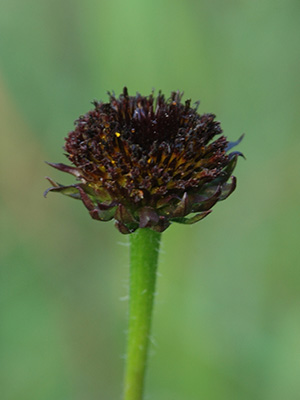A Haunted Garden
Frightfully Spooky Plants
What manner of creepy plants are lurking in the garden this Halloween? Whether you are making a witches’ brew, creating a sinister potion, or looking for an eerie vibe, these plants are sure to make anyone squeamish. From pungent to downright peculiar, these are just a handful of bloodcurdling plants to get you in that spooky mood.
Rayless Sunflower
The rayless sunflower (Helianthus radula) is not your typical sunflower—it lacks the showy petals of other members of the Asteraceae family and instead consists of tightly packed flowers at the end of a long stalk. The leaves of the rayless sunflower grow close to the ground while the flower extends upwards, reaching up to 3 feet. They are native to Florida and bloom in the summer and fall. The flower’s deep purple to brown color gives off dark and mysterious energy perfect for your ghostly garden.
Corpse Flower

The corpse flower (Amorphophallus titanium) knows how to make a statement—reaching 3 to 12 feet tall, this giant plant produces a flower that only remains open for 24 to 48 hours. During the first 6 to 12 hours after opening, the flower’s odor resembles the smell of rotting flesh, a delight to its pollinators but a ghastly experience for the human nose. The corpse flower is best enjoyed from a distance in a botanical garden.
Blood Lily
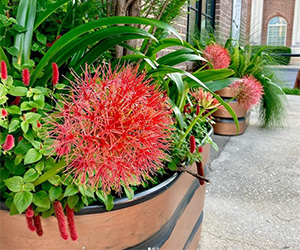
Blood lily (Scadoxus multiflorus) is sure to allure vampires with its blood-red blooms. The globe-shaped flower heads appear to hover in mid-air, adding to their spooky appeal. The plant can reach up to 2 feet in height with an orb of flowers up to 10 inches wide that bloom all summer long. At the base of each plant is a bulb characteristic of all lilies, which can be divided and replanted to grow more plants.
Devils-Walking Stick
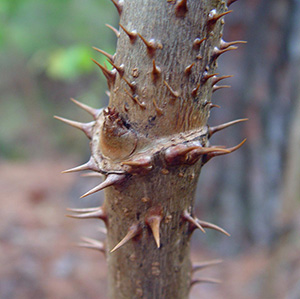
The treacherous thorns of the Florida native devils-walking stick (Aralia spinosa) and its menacing name are perfect for haunted graveyard ambiance. Even the huge leaves that can reach 4 feet long and 3 feet wide have pointed prickles ready to scratch the next admirer of its foliage. The tree generally reaches about 10 to 15 feet tall, and the leaves change to a copper and red in the fall, perfect for autumn vibes.
Black Petunias
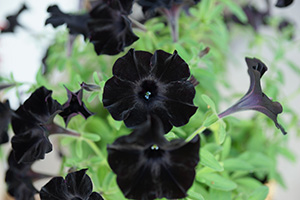
Black cultivars of petunia (Petunia x atkinsiana) bring a gothic feel to a garden, their deep purple color resembling the dreary black of night. This unusual plant has many dark and twisted cultivars such as ‘Black Cat’ (also sold as ‘Black Velvet’), ‘Phantom”, and ‘Pinstripe’. Their velvety appearance can be quite striking, making a dramatic addition to the landscape where only the brave dare venture.
Spider Flower

The spindly blooms of the spider flower, also called cleome, resemble those arachnids known to skitter around haunted mansions or forbidden forests. The plant blooms heavily throughout the summer season with whiskery, spider-like flowers that can grow up to 5 feet tall, adding significant height to any bewitching flower bed. Some of the older varieties are adorned with spines and put off an unpleasant odor, keeping ghoulish trespassers at bay.
Eyeball Plant
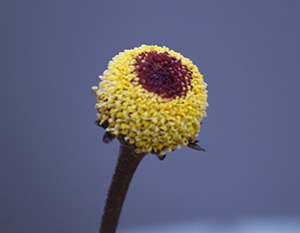
You can’t escape the frightfully realistic eyeball plant (Acmella oleracea), with flower heads about the size and shape of an olive and resemblant of an eyeball with a hauntingly red iris. This herbaceous plant flowers throughout the growing season and can reach 12 to 18 inches tall and wide. The leaves have been historically used as a medicinal herb for tooth pain, causing a spicy warmth followed by numbness in the mouth. But be careful what you do in its presence, for the eyeball plant is always watching.
Ghost Plant

Ghost plant (Graptopetalum paraguayense) is an unusual pale gray or whitish succulent that can sprawl outward, serving as an excellent ground cover plant. It can also be used in a container, cascading its branches down the sides for a creepy appeal. The leaves have a powdery coating called pruinose, which gives it that ghostly look. In the spring, star-shaped white flowers marked with blood-red emerge on flower stalks. This plant does well in the chilly, desolate weather, surviving in temperatures as low as 10˚Farenheight.
Bat Flower
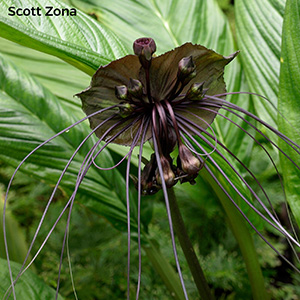
Bat flower (Tacca spp.) is an out-of-this-world plant that looks like it could take flight on a moonlit night. The plant has shiny, bright green tropical leaves and a cluster of purple flowers in the center, surrounded by two bracts (leaves that look like flower petals) that resemble bat wings. Even stranger, 8-to-10-inch threadlike bracteoles hang from the flowers, giving a whisker-like appearance. The plant blooms in Florida from late summer through fall and is sold as a specialty item around Halloween.

